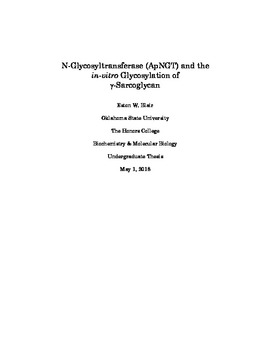| dc.contributor.author | Blair, Eston W. | |
| dc.date.accessioned | 2019-02-06T19:54:55Z | |
| dc.date.available | 2019-02-06T19:54:55Z | |
| dc.date.issued | 2018-05-01 | |
| dc.identifier | oksd_blair_HT_2018 | |
| dc.identifier.uri | https://hdl.handle.net/11244/317176 | |
| dc.description.abstract | N-Glycosyltransferase of Actinobacillus pleuropneumoniae (ApNGT) is an enzyme which performs N-linked glycosylation of proteins. Furthermore, ApNGT is a cytoplasmic glycosyltransferase with the ability to target heterologous proteins. This is important as it can establish precedent for promising glycoprotein biotechnology in-vitro (1). At 631 residues in length ApNGT mimics a triangular topology. It has two terminals and three domains, and its binding pocket lies between an AAD domain and two Rossmann-fold domains (2). ApNGT's function is part of a growing body of protein glycosylation research (3). Residues His-277 and Gln-469 in the binding pocket are crucial for catalytic activity. It stabilizes the UDP-glucose and acceptor peptide in place and greatly influences the glycosylation site of the peptide (4). It is an effective post-translational modification enzyme with an ability to glycosylate complex proteins while also having relaxed sugar substrate specificity (5) (Reviewed in Ref 6). Yet, it greatly prefers UDP- glucose in the cytoplasm, uses an inverting mechanism, and recognizes the NX(S/T) sequence of the acceptor peptide or protein, where X is any amino acid but not proline (7). ApNGT also has a relaxed-substrate specificity and so is useful for a variety of acceptor peptide substrates, for example, human erythropoietin (1). We propose in this particular review NGT's ability to in- vitro glycosylate the membrane protein g-Sarcoglycan. ApNGT allows for exploration of the structure and dynamics of glycosylated proteins. An appropriate protocol includes the combination of ApNGT, UDP-glucose, and g-Sarcoglycan to glycosylate the membrane protein. We can then perform NMR to identify structural, functional, and dynamic changes in the protein (8). This study will increase our understanding of how glycosylation affects the structure and dynamics of glycosylated proteins. It can also help with the diagnostics of various glycoprotein abnormalities. | |
| dc.format | application/pdf | |
| dc.language | en_US | |
| dc.rights | Copyright is held by the author who has granted the Oklahoma State University Library the non-exclusive right to share this material in its institutional repository. Contact Digital Library Services at lib-dls@okstate.edu or 405-744-9161 for the permission policy on the use, reproduction or distribution of this material. | |
| dc.title | N-Glycosyltransferase (ApNGT) and the in-vitro glycosylation of y-Sarcoglycan | |
| osu.filename | oksd_blair_HT_2018.pdf | |
| osu.accesstype | Open Access | |
| dc.type.genre | Honors Thesis | |
| dc.type.material | Text | |
| dc.contributor.director | Canaan, Patricia | |
| dc.contributor.facultyreader | Cook, Gabriel | |
| thesis.degree.discipline | Biochemistry and Molecular Biology | |
| thesis.degree.grantor | Oklahoma State University | |
